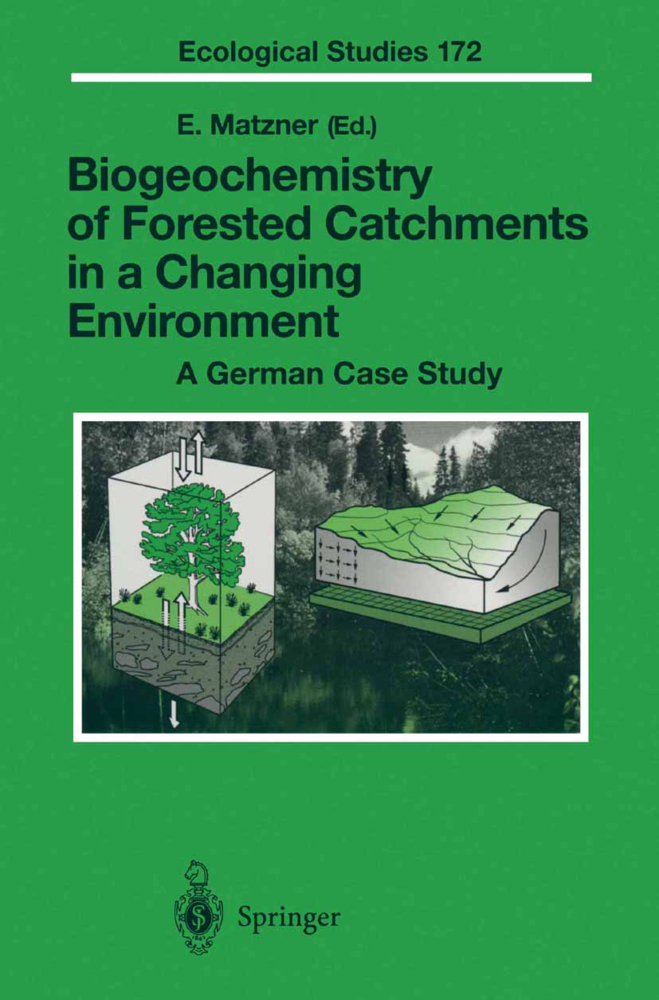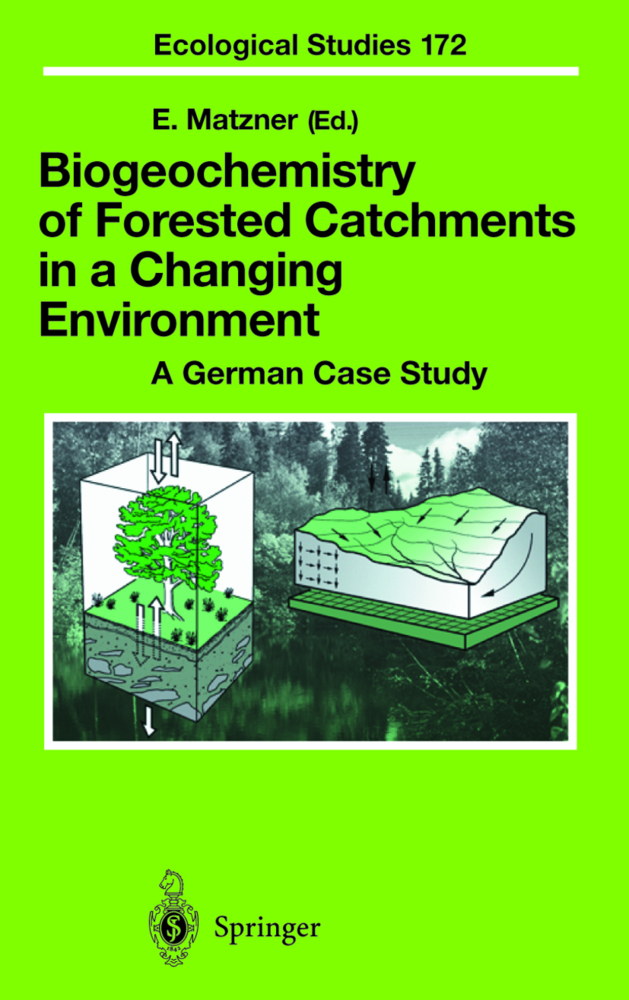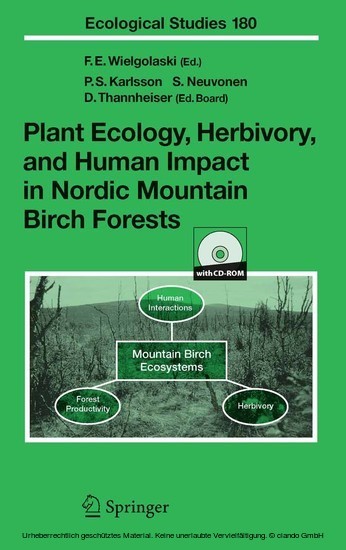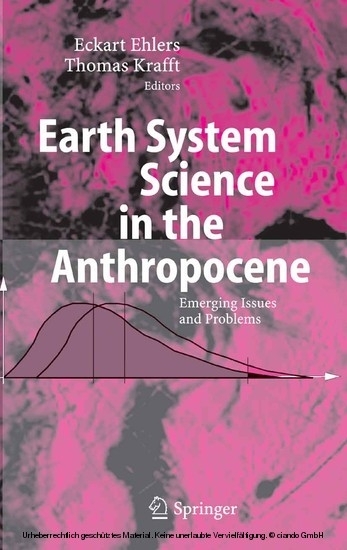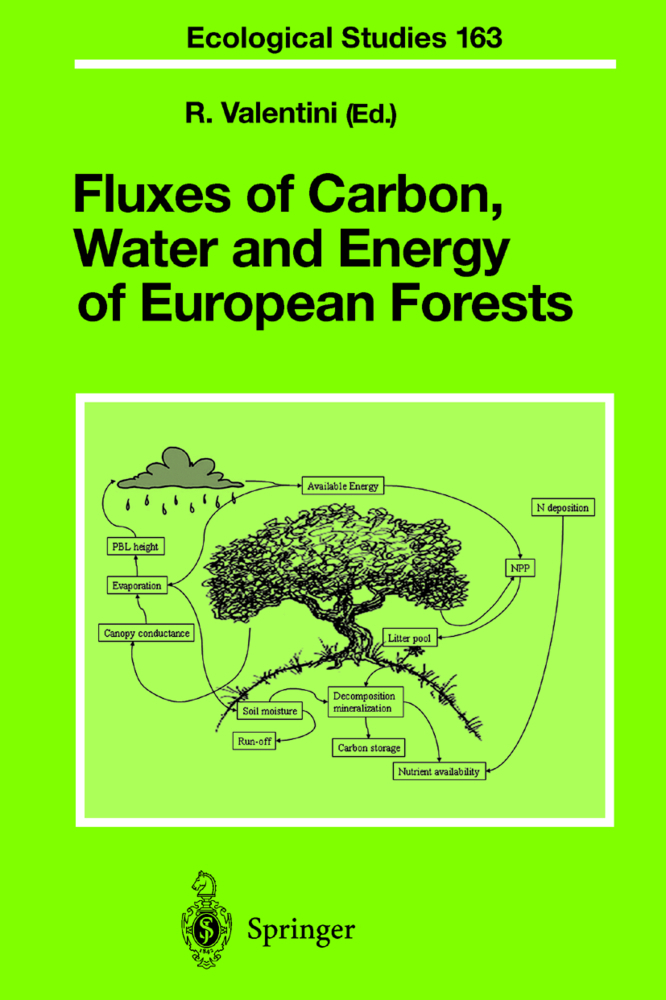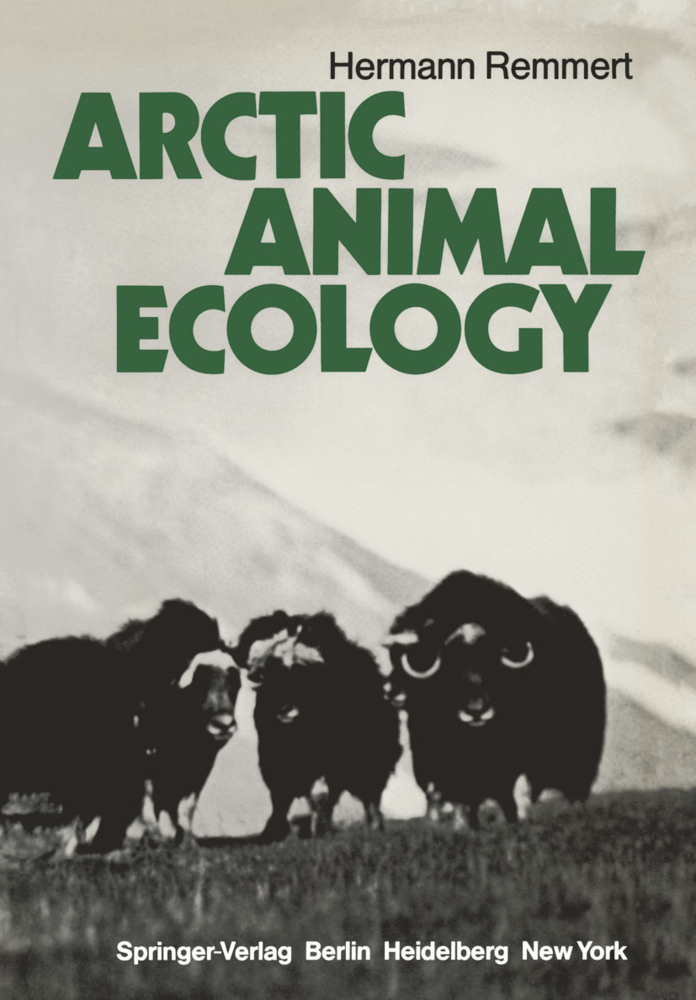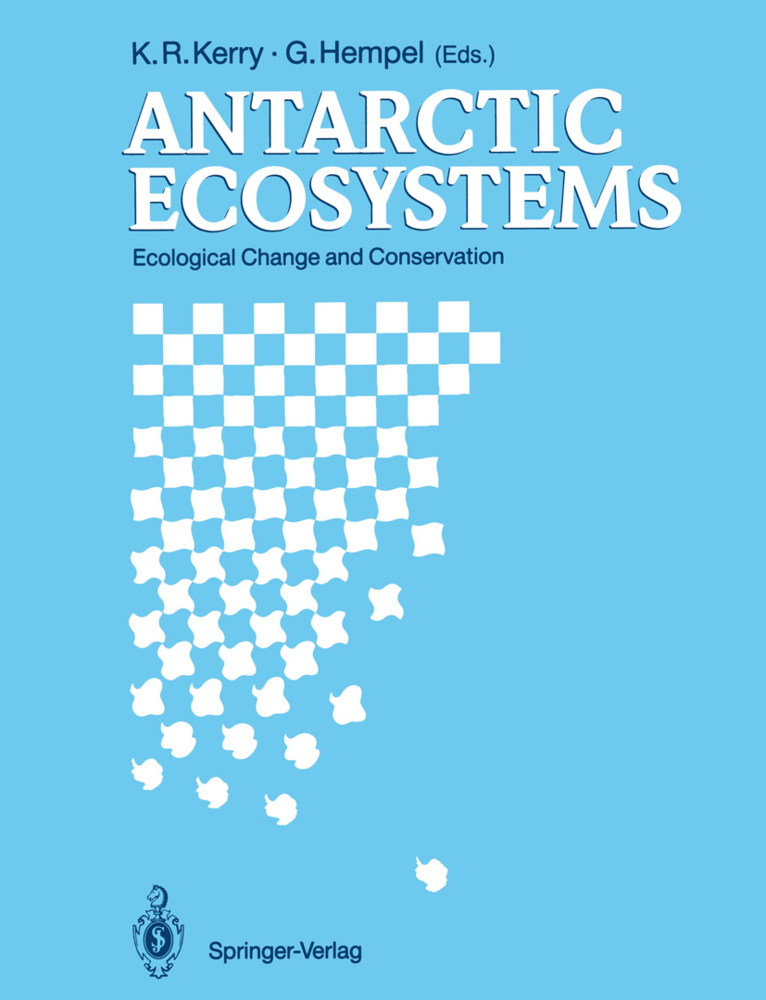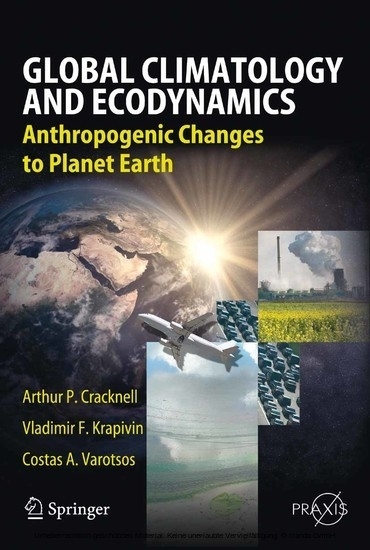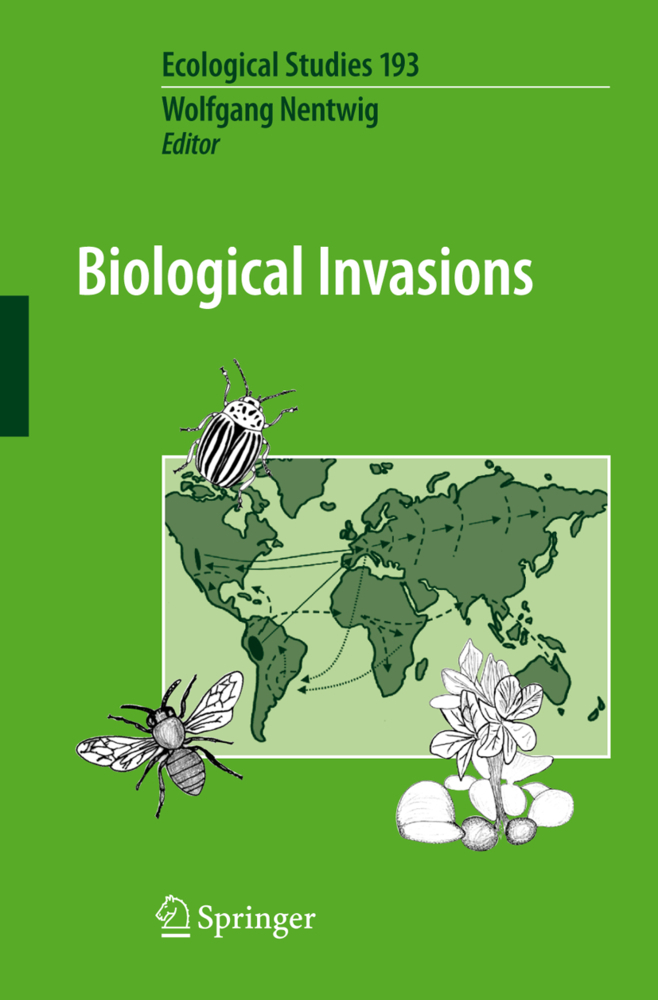Biogeochemistry of Forested Catchments in a Changing Environment
A German Case Study
Biogeochemistry of Forested Catchments in a Changing Environment
A German Case Study
Forest ecosystems represent a major type ofland use in Germanyand in Europe. They provide a number of functions, or ecosystem services, beneficial to humans, namely biomass production, regulation of the water- and energy cyde, C and N sequestration, erosion control, recreation, and they act as habitat for numerous species. The stability of forest ecosystems in Europe as influenced by the deposition of air pollutants has been a matter of debate for more than 20 years. Besides atmospheric deposition, other environmental conditions affecting forest ecosystems, such as temperature, CO content of the atmosphere 2 and precipitation, have significantly changed in the past and continue to change in the future. Quantifying and predicting the effects of these changes on ecosys tem functioning are achallenge to ecosystem research and also a requirement to establish sustainable use of forest ecosystems in the future. This book summarizes results of long-term, interdisciplinary ecosystem research conducted in two forested catchments and coordinated at the Bayreuth Institute of Terrestrial Ecosystem Research (BITÖK), University of Bayreuth, Germany. It does not aim to summarize all the research of BITÖ K in the past decade, which would go far beyond the studies in these two catch ments. Instead, we concentrate here on the long-term developments in the biogeochemistry of carbon and mineral elements and on the water cyde, at both the plot and the catchment scale.
2 The Lehstenbach and Steinkreuz Catchments in NE Bavaria, Germany
II The Changing Environment
3 Trace Gases and Particles in the Atmospheric Boundary Layer at the Waldstein Site: Present State and Historic Trends
4 Climate Change in the Lehstenbach Region
III Vegetation Response
5 Atmospheric and Structural Controls on Carbon and Water Relations in Mixed-Forest Stands of Beech and Oak
6 Impacts of Canopy Internal Gradients on Carbon and Water Exchange of Beech and Oak Trees
7 Soil CO2 Fluxes in Spruce Forests - Temporal and Spatial Variation, and Environmental Controls
8 Carbon Budget of a Spruce Forest Ecosystem
9 Structure of Carbon Dioxide Exchange Processes Above a Spruce Forest
10 Modeling the Vegetation Atmospheric Exchange with a Transilient Model
11 Fog Deposition and its Role in Biogeochemical Cycles of Nutrients and Pollutants
12 Turbulent Deposition of Ozone to a Mountainous Forest Ecosystem
13 The Emissions of Biogenic Volatile Organic Compounds (BVOC) and Their Relevance to Atmospheric Particle Dynamics
14 Trends in Deposition and Canopy Leaching of Mineral Elements as Indicated by Bulk Deposition and Throughfall Measurements
15 Phyllosphere Ecology in a Changing Environment: The Role of Insects in Forest Ecosystems
16 Element Fluxes with Litterfall in Mature Stands of Norway Spruce and European Beech in Bavaria, South Germany
17 The Role of Woody Roots in Water Uptake of Mature Spruce, Beech, and Oak Trees
18 Radial Growth of Norway Spruce [Picea abies (L.) Karst.] at the Coulissenhieb Site in Relation to Environmental Conditions and Comparison with Sites in the Fichtelgebirge and Erzgebirge
IV Soil Response
19 Environmental Controls on Concentrations and Fluxes of DissolvedOrganic Matter in the Forest Floor and in Soil Solution
20 Response of Soil Solution Chemistry and Solute Fluxes to Changing Deposition Rates
21 Sequestration Rates for C and N in Soil Organic Matter at Four N-Polluted Temperate Forest Stands
22 Riparian Zones in a Forested Catchment: Hot Spots for Microbial Reductive Processes
V Catchment Response
23 Dynamics of Runoff and Runoff Chemistry at the Lehstenbach and Steinkreuz Catchment
24 Trends in the Input-Output Relations: The Catchment Budgets
VI Synthesis
25 Biogeochemistry of Two Forested Catchments in a Changing Environment: A Synthesis.
I Introduction
1 Introduction2 The Lehstenbach and Steinkreuz Catchments in NE Bavaria, Germany
II The Changing Environment
3 Trace Gases and Particles in the Atmospheric Boundary Layer at the Waldstein Site: Present State and Historic Trends
4 Climate Change in the Lehstenbach Region
III Vegetation Response
5 Atmospheric and Structural Controls on Carbon and Water Relations in Mixed-Forest Stands of Beech and Oak
6 Impacts of Canopy Internal Gradients on Carbon and Water Exchange of Beech and Oak Trees
7 Soil CO2 Fluxes in Spruce Forests - Temporal and Spatial Variation, and Environmental Controls
8 Carbon Budget of a Spruce Forest Ecosystem
9 Structure of Carbon Dioxide Exchange Processes Above a Spruce Forest
10 Modeling the Vegetation Atmospheric Exchange with a Transilient Model
11 Fog Deposition and its Role in Biogeochemical Cycles of Nutrients and Pollutants
12 Turbulent Deposition of Ozone to a Mountainous Forest Ecosystem
13 The Emissions of Biogenic Volatile Organic Compounds (BVOC) and Their Relevance to Atmospheric Particle Dynamics
14 Trends in Deposition and Canopy Leaching of Mineral Elements as Indicated by Bulk Deposition and Throughfall Measurements
15 Phyllosphere Ecology in a Changing Environment: The Role of Insects in Forest Ecosystems
16 Element Fluxes with Litterfall in Mature Stands of Norway Spruce and European Beech in Bavaria, South Germany
17 The Role of Woody Roots in Water Uptake of Mature Spruce, Beech, and Oak Trees
18 Radial Growth of Norway Spruce [Picea abies (L.) Karst.] at the Coulissenhieb Site in Relation to Environmental Conditions and Comparison with Sites in the Fichtelgebirge and Erzgebirge
IV Soil Response
19 Environmental Controls on Concentrations and Fluxes of DissolvedOrganic Matter in the Forest Floor and in Soil Solution
20 Response of Soil Solution Chemistry and Solute Fluxes to Changing Deposition Rates
21 Sequestration Rates for C and N in Soil Organic Matter at Four N-Polluted Temperate Forest Stands
22 Riparian Zones in a Forested Catchment: Hot Spots for Microbial Reductive Processes
V Catchment Response
23 Dynamics of Runoff and Runoff Chemistry at the Lehstenbach and Steinkreuz Catchment
24 Trends in the Input-Output Relations: The Catchment Budgets
VI Synthesis
25 Biogeochemistry of Two Forested Catchments in a Changing Environment: A Synthesis.
Matzner, Egbert
| ISBN | 978-3-642-05900-1 |
|---|---|
| Artikelnummer | 9783642059001 |
| Medientyp | Buch |
| Copyrightjahr | 2011 |
| Verlag | Springer, Berlin |
| Umfang | XXII, 500 Seiten |
| Abbildungen | XXII, 500 p. |
| Sprache | Englisch |

